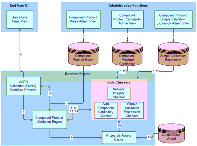|
Siebel Order Management Guide Addendum for Industry Applications > Setting Up Network Ordering >
About the Compound Product Validation Engine and the Projected Asset Cache
The Compound Product Validation Engine executes validation rules that cross product instances. A compound product is a group of product instances in quote, order and asset tables that share a common key. A frame relay network is a good example of a compound product. The Compound Product Validation Engine allows you to create rules that operate on a projected future state of a compound product that includes the current quote and any open orders on the existing assets. This future state is created and stored in the Projected Asset Cache object. Overview of Compound Product Validation
The following diagram illustrates how the Compound Product Validation Engine and its supporting components validate a compound product when a user clicks Validate.
Figure 66. Steps in Compound Product Validation
|
Compound product validation involves the following actions, shown in Figure 66:
- Step 1. Product manager defines the cross-product validation business services rules for the top-level product in the Compound Product Rules Admin View. See Defining Rule Checker Business Services.
- Step 2. Product manager defines the component cardinality rules for the top-level product in the Compound Product Cardinality Admin View and enters basic validation rules in the Compound Product Simple Validation Expression Admin View. See Defining Maximum and Minimum Quantities for Network Components and Defining Simple Expression Rules for Compound Products
- Step 3. The end user creates a change quote for the compound product. The user validates the individual components using Configurator. After exiting Configurator and completing the network connections, the user clicks Validate. The Validate button invokes a named method on the Quote Item Business Component which invokes the VORD Validate (Quote) workflow process.
- Step 4. The VORD Validate (Quote) workflow process determines the selected compound product instance. It also determines the future date for which to validate the network based upon the latest requested date of quote line items for the network. See the Future Date step in VORD Validate (Quote). It then calls the Compound Product Validation Engine business service.
- Step 6. The Compound Product Validation Engine retrieves the compound product validation rules for the top-level product. See the Validate step in VORD Validate (Quote).
- Step 6. For each rule, the Compound Product Validation Engine invokes the Pre-Validate method on the corresponding business service.
- Step 7. If necessary, the rules checker business service retrieves product specific data related to the rule (for example, the cardinality constraints for sub-components of the compound product).
- Step 8. The rule checker determines what fields and attributes it will require and returns them to the Compound Product Validation Engine which accumulates a list of fields and attributes required by all rules checkers.
- Step 9. The Compound Product Validation Engine instructs the Projected Assets Cache to retrieve the compound product instance limited to fields and attributes required by the business service validation rules associated with the compound product.
- Step 10. The Projected Assets Cache retrieves all asset records for the compound product. It then retrieves all open order line items due to complete before the specified due date and updates the records retrieved from the asset table to create a future state. Finally, all changes to the compound product instance in the current quote or current order are applied to generate the true future requested state.
- Step 11. For each rule, the Compound Product Validation Engine invokes the associated rules checker business service method.
- Step 12. If necessary, the rules checker business service retrieves product specific data related to the rule (for example, the cardinality constraints for sub-components of the compound product).
- Step 13. The rules checker business service queries the Projected Assets Cache in order to evaluate the rule (for example, it gets the bandwidth for each PVC connected to a node).
- Step 14. The rules checker business service returns a list of rule violations to the Compound Product Validation Engine.
- Step 15. The Compound Product Validation Engine accumulates the rule violations for each rule and returns them to VORD Validate (Quote) workflow process.
- Step 16. The Format method of the Compound Product Validation Engine business service formats an error message and displays it to the end user.
NOTE: The Compound Product Validation Engine operates independently of a customizable product definition. Furthermore, the engine only validates the top level component and its immediate attributes. This point will affect your modeling of Network products.
| 



